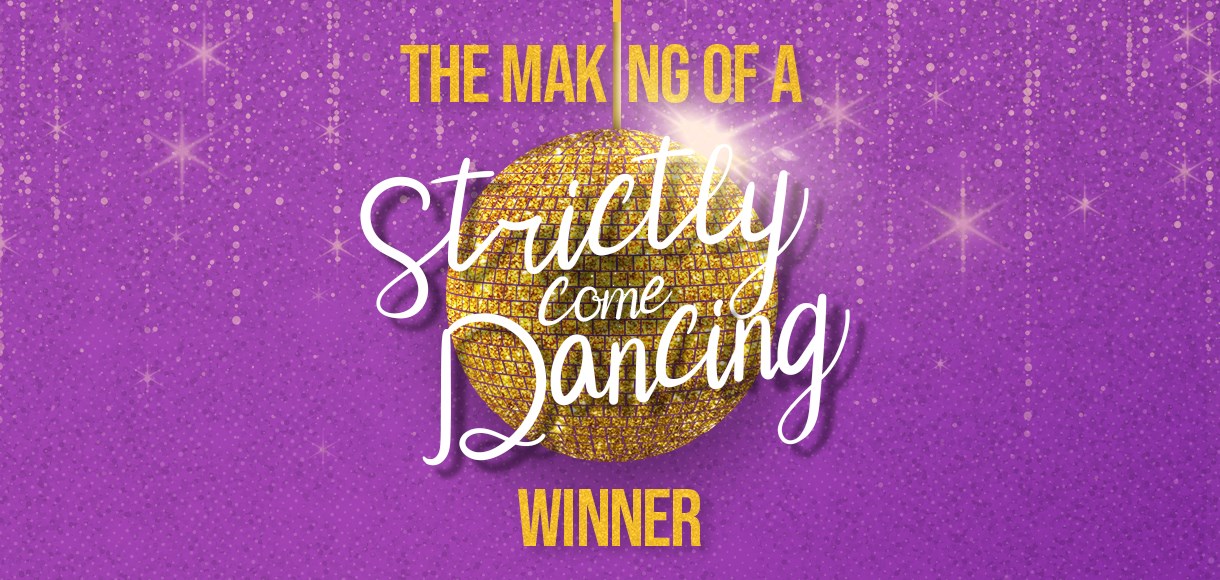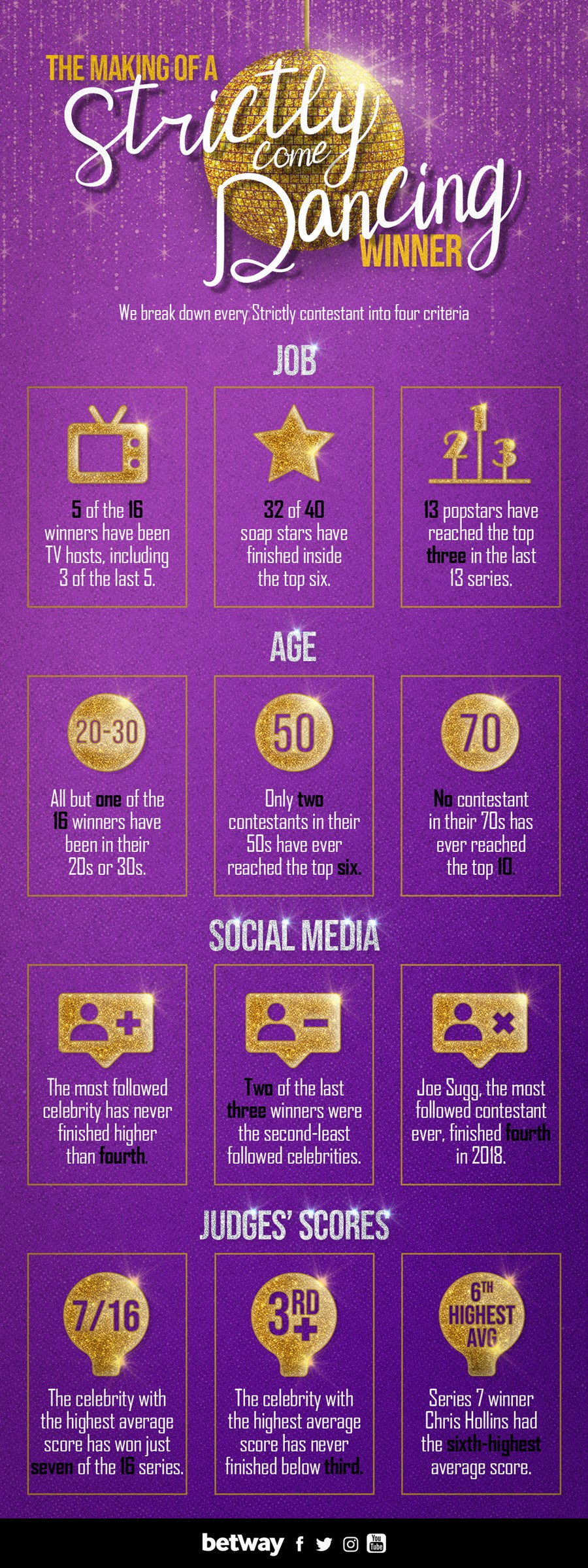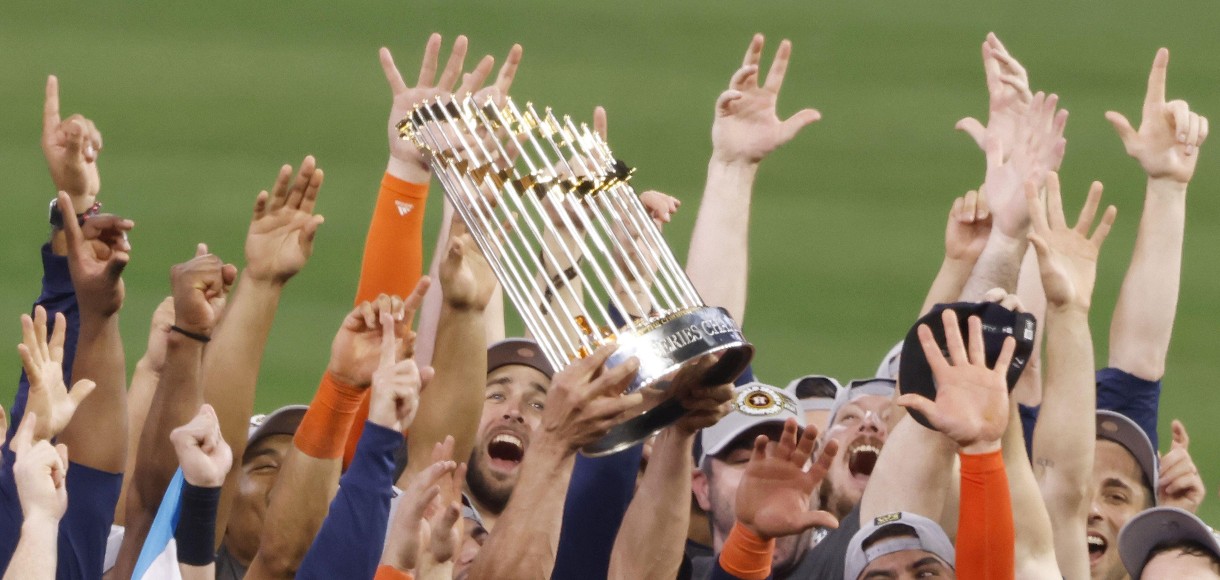Keep Dancing: Analysing every Strictly Come Dancing winner

From Alesha Dixon to Ann Widdecombe, our infographic analyses every Strictly winner by age, job, social media following and judges' scores.
The stage is set, the glitter ball is polished, and Claudia Winkleman’s fringe is perched perfectly on her eyebrows.
After nine months of barren Saturday nights, it’s time for series 17 of Strictly Come Dancing.
Seventeen series. That’s a lot of television.
But while the show was a novelty when it launched on BBC One in 2004, watching celebrities with different backgrounds, experiences and reputations attempt to revive or enhance their careers through ballroom dance has proved to be compelling viewing.
Strictly is the most-watched series in the UK, with the 2018 series averaging just under 9.5 million viewers.
Indeed, it’s so popular that you can even have a bet on it. CBBC presenter Karim Zeroual is our favourite in the online betting market to win this year’s show.
But how do you differentiate one amateur dancer from another? We evaluated every one of the show’s previous 222 contestants to determine the blueprint for Strictly Come Dancing success.
JOB
It turns out that avid television fans will generally vote for celebrities that they recognise from… the television.
Five of the 16 Strictly Come Dancing winners (31.25 per cent) have been TV presenters, including three of the last five: Caroline Flack, Ore Oduba and Stacey Dooley.
When you consider that four winners have been soap stars, it’s clear that personalities rammed into our eyeballs on a daily basis fare best.
Residents of Albert Square, Coronation Street, Hollyoaks and the rest are also very consistent performers.
Of 40 soap actors to ever take part in Strictly, 32 (80 per cent) have finished in the top seven and 16 inside the top three.
With a unique combination of popularity, prior experience, innate charisma and the whiff of a career in decline, popstars have nailed the skill of doing well but failing to win.
Since series 4, 13 popstars – usually band members – have reached the top three, but only three have gone on to win: Alesha Dixon, Harry Judd and Jay McGuiness.
That is in contrast to sportspeople, who, excluding the glory years of Darren Gough and Mark Ramprakash in the first three series, have failed to live up to the standards they set themselves in their professional careers.
Only Olympian Louis Smith has reached the final since Gough and Colin Jackson in 2005, winning series 10.
Joe Sugg, the first Youtuber ever to take part in Strictly, finished fourth in 2018.
AGE
Ballroom dancing is hard work, so it makes sense that celebrities in peak physical condition are the most likely to succeed.
Of the 32 celebrities to ever finish in the top two, all but one (3.125 per cent) have been in their 20s or 30s, with the one exception – series 15 winner Joe McFadden – aged 41.
Celebrities in their 20s have the best chance of success.
Of the 44 contestants aged 20+, 18 (40.9 per cent) have finished in the top half, with seven (15.9 per cent) winning.
The outlook is bleak for older contestants.
Celebrities in their 50s have to be exceptional to progress far. Of 28 contestants in that age bracket, only two (7.14 per cent) – Debbie McGhee and Pamela Stephenson, both of whom reached the final – have reached the top six.
Of those in their 60s, only Anne Widdicombe – who was dreadful, so naturally gained popularity – finished inside the top six (5.88 per cent).
All of the three contestants aged 70+, Paul Daniels, Johnny Ball and Lesley Joseph, fell short of the top 10.

SOCIAL MEDIA FOLLOWING
Strictly is popular among the older generation, so it’s no surprise that online fame and popularity doesn’t have a massive impact on voters.
In the last five series of Strictly, the most-followed contestant on Twitter has never finished any higher than fourth, with Laura Whitmore as low as ninth in 2016.
OK, the second-most followed celebrity finished in the top two in four consecutive series between 2014-2017, but that seems little more than coincidence.
The winners in both 2016 and 2017, Ore Oduba and Joe McFadden, were the second-least followed celebrities heading into the series.
Peter Andre and Joe Sugg, comfortably the two-most followed contestants ever, both failed to finish inside the top three.
JUDGES’ SCORES
The celebrity with the highest average score from the judges has only won seven times in 16 series (43.75 per cent), which leads us to one dreadful conclusion: the best dancer usually doesn’t win Strictly Come Dancing.
The last contestant to combine master craftsmanship with popularity was Jay McGuiness in 2015. Since then, our cynical general public (yes, you) has turned against the best performers in favour of those punching above their weight..
Voters have failed to crown Danny Mac, Alexandre Burke and Ashley Roberts – the best dancers in each of the last three series – winners, with all of the last three champions ranking third for their average score from the judges.
We really can’t be trusted.
The nature of the Strictly scoring system – judges’ and public vote split 50/50 – means that the best dancers will always finish somewhere near the top, though.
The best dancer has finished in the top two in each of the last 12 series, but seven of them have finished second. The lowest that the best dancer has ever finished is third – Zoe Ball in series 3 and Emma Bunton in series 4.
Series 7 winner Chris Hollins won the series, but he did so through sheer force of popularity. Hollins was the sixth-best dancer, according to the judges, but won the competition.
Everybody loves a no-hoper, and being useless can help you overachieve, too.
Anne Widdicombe was the worst dancer of all 14 celebrities in series 8, yet finished sixth – above the fifth-best Jimi Mistry.
John Sergeant couldn’t bring himself to go that far.
He pulled out of the show in seventh position in series 6, after his poor dancing – the third-worst of 16 celebrities that year – became so popular that “there was a real danger I might win the competition. Even for me, that would be a joke too far.”
Ed Balls was the second-worst of 15 dancers in series 14, but finished sixth.




































